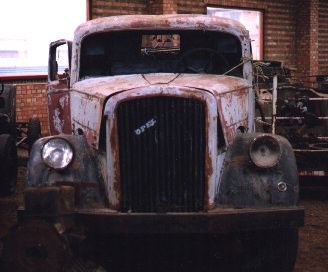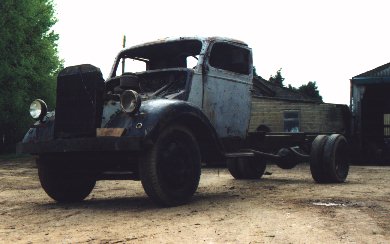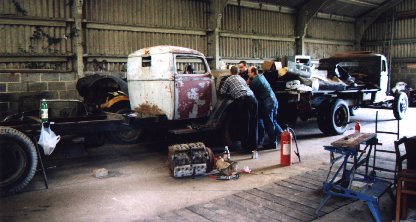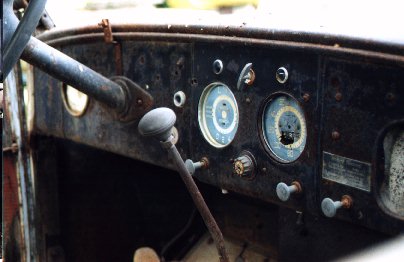

The SBG's Opel Blitz
In August of 1998 the SBG was offered the choice of two W.W. II German 3 Ton Opel Blitz trucks . The first Blitz was an un-restored model but in very good condition for £3500. The other was in much poorer condition but had been used privately within the last 10 years and was offered to us at £1750. After putting the prospect to the SBG membership it was decided to buy the cheaper model as the funds would be easier to gather quickly. In total 42 members contributed to the purchasing of the truck and subsequent restoration. Although we paid for the Blitz in the autumn of 1998 we did not take delivery of the vehicle until April 1999. This particular Opel is a 1941 model and was used in Norway as part of a flak kompanie.
At what first seemed to be an easy and straightforward restoration turned out to be an almost colossal undertaking with a total cost in excess of £5000 and much hard work and group co-operation. It must be mentioned at this point that Hscha. Siegel was THE driving force behind the restoration (from start to finish) and without his total dedication, enthusiasm and drive the Blitz would still only be half restored!.
Here is a step by step report of the SBGs Opel Blitz restoration program. Each section is reproduced from our magazine Signal ..................
Sunday 25th April.
 Sunday 25th April saw the first work
party arriving at our home site in Kent for an initial
examination of our recently delivered Opel Blitz truck. First on
the scene was Uscha. Möckel and myself and as the garage doors
were slid back and we set our eyes on the truck for the first
time we both muttered "Mein Gott".....in disappointment
!. To say the least it looked in a very sorry state with one
wheel pointing in a 90 degree angle to the other wheel and one
side of the cab had "dropped". However, appearances can
be deceiving and that was certainly the case in this instance.
After a full examination of the vehicle it simply looked worse
than what it actually was. The chassis (although probably the
easiest item to work on/repair) was immaculate. The cab had
"dropped" on one side and no one could envisage at that
time what a major job repairing the cab would be !. The rest of
the vehicle i.e. bonnet, wings etc. had only light superficial
wear. The fact that a large German W.W. II trailer and German
made Ford V8 engine was also on the back of the truck did nothing
to help is appearance.
Sunday 25th April saw the first work
party arriving at our home site in Kent for an initial
examination of our recently delivered Opel Blitz truck. First on
the scene was Uscha. Möckel and myself and as the garage doors
were slid back and we set our eyes on the truck for the first
time we both muttered "Mein Gott".....in disappointment
!. To say the least it looked in a very sorry state with one
wheel pointing in a 90 degree angle to the other wheel and one
side of the cab had "dropped". However, appearances can
be deceiving and that was certainly the case in this instance.
After a full examination of the vehicle it simply looked worse
than what it actually was. The chassis (although probably the
easiest item to work on/repair) was immaculate. The cab had
"dropped" on one side and no one could envisage at that
time what a major job repairing the cab would be !. The rest of
the vehicle i.e. bonnet, wings etc. had only light superficial
wear. The fact that a large German W.W. II trailer and German
made Ford V8 engine was also on the back of the truck did nothing
to help is appearance.
 Not wasting a precious second Uscha.
Möckel set to work removing the engine cowlings and front grill
(which were almost immaculate) allowing easy access to the engine
which was remarkably complete. A crank handle was found and using
this Uscha. Möckel successfully turned the engine over by hand.
The front of the vehicle was jacked up, and the road wheels
removed. Uscha. Möckel then proceeded to take off the track rod
ends tie bar which instead of being straight was S shaped. The
oxy/acetylene equipment was set up and for the next hour Uscha.
Möckel proceed to heat up, bash and completely straighten the
bar. This was refitted and with the front wheels aligned the
truck was looking better already !.
Not wasting a precious second Uscha.
Möckel set to work removing the engine cowlings and front grill
(which were almost immaculate) allowing easy access to the engine
which was remarkably complete. A crank handle was found and using
this Uscha. Möckel successfully turned the engine over by hand.
The front of the vehicle was jacked up, and the road wheels
removed. Uscha. Möckel then proceeded to take off the track rod
ends tie bar which instead of being straight was S shaped. The
oxy/acetylene equipment was set up and for the next hour Uscha.
Möckel proceed to heat up, bash and completely straighten the
bar. This was refitted and with the front wheels aligned the
truck was looking better already !.
 Finally we were joined by Hscha. Siegel,
Schar. Meyer, Rttf. Ihssen, Strm. Wörner and Strm. Adams. Using
a tractor/fork lift the Blitz was towed out of the barn and the
trailer/ Ford engine removed from the flat bed. Once this was
done the Blitz was given a brush over and looked much better
already !. I think the hardware on the back made the truck look
messy but with that gone the appearance was much better. We then
proceed to re- organize and clean up the barn and after taking a
few photographs the Blitz was then repositioned inside.
Finally we were joined by Hscha. Siegel,
Schar. Meyer, Rttf. Ihssen, Strm. Wörner and Strm. Adams. Using
a tractor/fork lift the Blitz was towed out of the barn and the
trailer/ Ford engine removed from the flat bed. Once this was
done the Blitz was given a brush over and looked much better
already !. I think the hardware on the back made the truck look
messy but with that gone the appearance was much better. We then
proceed to re- organize and clean up the barn and after taking a
few photographs the Blitz was then repositioned inside.
Then it was time to work on the engine !. Whilst Schar. Meyer and
Strm. Adams worked on the brakes Hscha. Siegel, Uscha. Möckel
and Strm. Wörner worked on the engine. We used the batteries
from the Half track and to our surprise the Blitz' engine turned
over faultlessly (with no apparent knocks or rattles !) but,
alas, would not fire. The mechanical and enginerring knowledge of
those present was very impressive and over the next few hours the
engines electrics and fuel system was ripped to pieces and by the
end of the day the engine was almost in running order with the
occasional backfire and blast from the exhaust pipe. However, it
seemed the carburetor needed overhauling and the timing needed
rectifying but, alas, time was not on our side and with light
failing we decided to call it a day.
 To sum up, a terrific days work
was done in just a few hours by all present with the steering
gear straightened out, the hardware on the flatbed removed, the
vehicle tidied up, work on the braking system started, the
exhaust removed and the engine almost firing. The biggest
problem was the "dropped" cab but Strm. Adams contacted
a suitable carpenter and it was hoped the cab would be repaired
within the week.
To sum up, a terrific days work
was done in just a few hours by all present with the steering
gear straightened out, the hardware on the flatbed removed, the
vehicle tidied up, work on the braking system started, the
exhaust removed and the engine almost firing. The biggest
problem was the "dropped" cab but Strm. Adams contacted
a suitable carpenter and it was hoped the cab would be repaired
within the week.